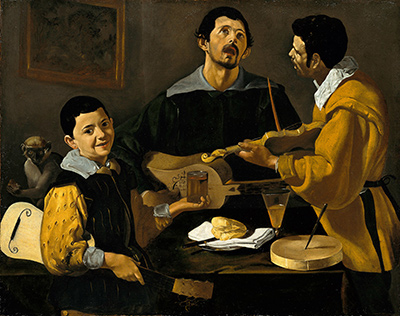The Three Musicians
Diego Velazquez studied art from childhood and painted The Three Musicians in Seville in around 1616, when he was just seventeen years old.

It is one of a group of ten or so paintings he created featuring simple domestic settings, a style sometimes called 'bodegón', popular in Spain at that time. As with his later works, The Three Musicians, one of his earliest paintings, uses the 'chiaroscuro' technique, which juxtaposes bright light against deep, intense dark tones to create a sense of depth in the picture. His 1618 work, Old Woman Frying Eggs, is another similar work from this period.
The painting is a complex composition, and although the palette is limited, the colours are vibrant and the textures varied. The musicians are the principal subject and make a satisfying picture by themselves. Velazquez, however, has added another depth to this painting of an everyday setting by his inclusion of other, more allegorical elements. On the table there is a supper of wine, bread and a whole cheese, referring perhaps to the idea that, as Shakespeare wrote in Twelfth Night in 1602, music may be the food of love.
Two of the musicians, the fiddler and the guitar player, are playing and singing. The youngest is not playing but has his instrument, which seems to have a broken string, tucked under his right arm while with his left hand he gestures towards the others with a glass of ale. He smiles out at us, suggesting that the recital may be a little alcohol-inspired.
On the far left of the picture, tucked into the shadows, sits a small black-faced monkey, possibly a Langur, clutching a pear in its paw. Travelling musicians in this period often kept monkeys to dance and caper as they played, adding amusement to their performance. Monkeys are frequently associated with the grotesque when portrayed in art.
Velazquez, born in Seville in 1599, studied painting at the studio of his future father-in-law, Francisco Pacheco, a successful artist and teacher. Clearly talented, Velazquez soon became successful and moved to Madrid in 1622. In 1623 he painted a portrait of King Philip IV of Spain who thought so highly of his work that he employed him and paid him a generous salary in addition to financing the move of the Velazquez family to his court. Over the following thirty five years Velazquez remained close to the court and painted most of the members of the Spanish royal family. He died in Madrid in 1660, leaving behind him a substantial legacy of work that continues to inspire artists across the globe.